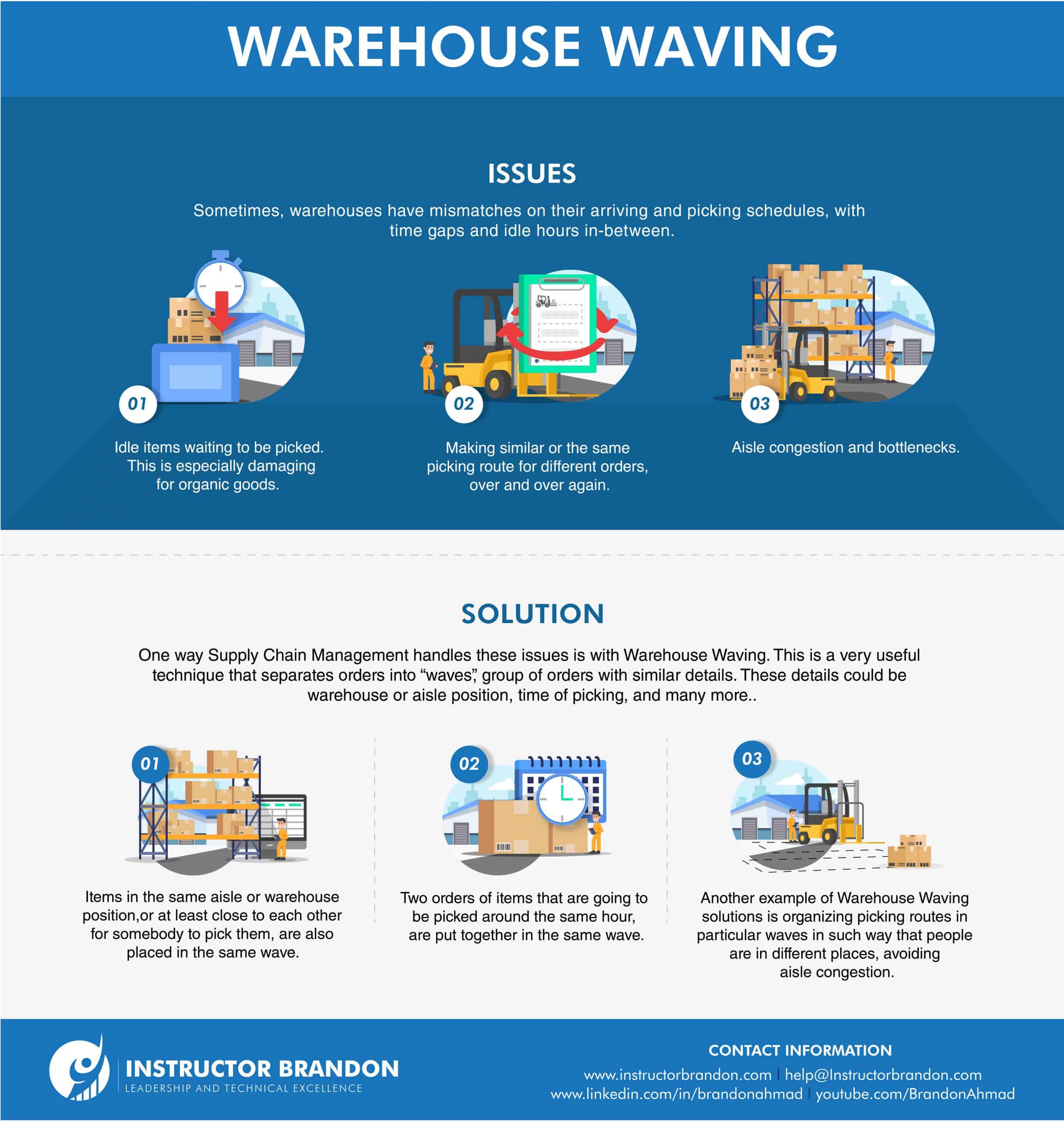Supply Chain and Logistics Management
Dynamics 365 Wave Picking Tutorial for Dummies Like Me Part 1
Dynamics 365 Wave Picking Tutorial For Dummies – Instructor Brandon
Some people understand complicated things in five minutes, and then there are people like me who have to work on it. Shoot, some of these things are complicated. I can honestly say that it took me months to fully understand waving in Dynamics AX/365. However, when I got it, it made a difference. After this Microsoft Dynamics 365 wave picking tutorial, you will get it too.
I was able to create solutions where I made KPI’s and tied in capacity utilization on specific wave process in Microsoft Dynamics, show wave picking throughput in regards to shifts, speed up the Waving and Load planning workbench processes together, etc. Plus, I got to make some cool Power BI stuff on warehousing.
So, without further delay, let’s talk about waving. First, let’s go through it from the perspective of this custom infographic that we’ve made. It makes the concept quite clear. Imagine there are 6 groups of people, all of them want to pick items out of an aisle, but there are way too many of them to do that! So, what you do is schedule them. Then, they can operate more efficiently without all the clutter. That’s the simple explanation to start with. Study the picture and notice how it illustrates that concept. Zoom in on the MS Dynamics 365 Wave Picking infographic and you will notice that very clearly.
Microsoft Dynamics 365 wave picking tutorial by Instructor Brandon explains how to increase productivity by managing people, processes and technology.
Microsoft Dynamics Wave Picking

The Warehousing in Wave Picking
Warehousing is one of the key components in the world of the supply chain. With significance to business outfits that import, export, transitory support provision companies, manufacturing facilities, and transportation services. Having your warehouse for your products gives you the required control over the overall business inventory.
This results in saving money and adding efficacy and productivity. Warehousing also results in control over managing healthy stock and timeframes for dispatch(s). This control reflects on picking, packaging, and sending accurate orders to the customer. Building a good reputation and yielding trust.
Before we select a picking method for our warehouse, we need to evaluate the situation at hand keeping in view the following metrics:
- Current Inventory situation
- Available technology
- Workforce
- Warehouse layout
Once we consider all of these factors, we can now confidently determine a picking methodology (or a combination of methodologies) that meets our requirements. From a macro viewpoint there are two basic pick mechanisms:
Talking about Process-Based Picking and Layout Based Picking. The first one is focused on the way an order is picked, while the other takes into account the organization of the picking area and the operational flow.
Six Key Inefficiency Challenges in Wave Picking
While considering warehouse management operations, there are six key inefficiency challenges that Wave Picking can satisfactorily resolve:
- Inventory Inaccuracy
- Inventory Location
- Warehouse Layout
- Redundant Processes
- Human Error
- Picking Optimization
Some consider wave picking as a variation to batch picking or zone picking, which is almost the case when you consider how the other methodologies work. Batch picking involves a picker moving through the warehouse collecting goods for several orders at once, zone picking involves pickers dedicated to a specific section passing order totes from one zone to the next. With wave picking all the orders are grouped and then picked into batches at specific times of the day.
Dynamics 365 Wave Picking: How does it work?
An efficient wave picking process starts with the IMS (Inventory Management System) and the WMS (Inventory & Warehouse Management System). This System software creates a consolidated “Pick List” based on variables, including but not limited to:
- Customer delivery guarantees
- Customer delivery regions
- Transportation scheduling
- Load times
- Warehouse staffing
- Equipment needs to pick
- Warehouse layout
The IMS applies these stated variables to create the most efficient time-based pick lists possible and divides them into waves. Wave picking creates an efficacy factor that is not achievable manually and provides a structured process to fulfill orders. In some cases, pick lists are sorted in terms of size and shape to maximize the utilization of cart space.
Wave picking yields strong benefits, but it is not the preferred solution for every warehouse or every situation. Since different picking jobs can take different timeframes to complete, if not planned right, workers may experience downtime while waiting for wave pickers to complete their work. There is also the possibility of errors as items are picked in waves and still need to go through sorting in the staging area.
Wave picking is useful for both low-pick and high-pick operations. For low-pick operations, wave picking reduces the number of trips workers take back and forth. For high-pick operations, warehouse managers couple wave picking with zone picking to run the most efficient workflow possible.
Warehouse Waving Issues & Solutions

Pick Waves, Pack Waves & Replenishment Waves
Picking is one of the most strenuous activities in a warehouse, therefore the pick wave is referred to as the most important type of wave. We can generate pick waves based on a group of “Same Day Shipment” locations, the customer (pick all Costco orders in this wave), order prioritization (after 2 pm, only pick high priority orders), product attributes (pick fragile cargo in one wave, ceramics in the next), or other parameters. A pick wave generally consists of 30 minutes to 2 hours.
Pack wave is a subtype of pick wave that is sensitive to the constraints of material handling equipment. These sortation systems have certain throughput constraints. In this specific instance, the pick wave is broken into smaller pack waves that are sensitive to these material handling constraints.
Replenishment Waves
Replenishment waves occur in high-throughput facilities that need to regularly push goods from bulk storage to forward pick locations. The replenishment wave is linked to the pick wave, So once a pick wave is Compiled, the replenishment wave ensures that the necessary inventory to support the picking will be in the forward pick locations.
Replenishment waves are particularly important in DCs that have more stock-keeping units (SKUs) then forward pick slots. In such types of warehouses, a slot is filled with an SKU to meet the needs of a pick wave, then filled with a different SKU to meet the need of the next pick wave. This form of replenishment wave is dependent on the construction logic used in the compiling of the pick wave.
While in smaller throughput facilities, the replenishment wave is independent of a particular pick wave. For example, a supervisor might look at next week’s orders, determine where SKUs should be slotted in the forward pick areas and what the minimum and maximum levels at an individual picking location should be, and then create a wave of work at the beginning of the week to set up the forward pick locations.
Cartonization
Cartonization is an affiliated activity to wave picking. This is a process that automatically determines the number of shipping cartons required for a single order based on a specific product(s) and carton dimensions. Cartonization takes into consideration, metrics like the weight tolerance of cartons and shippers. Warehouse workers are then instructed to place products into a specific shipping carton, pre‐determined by the Cartonization function.
The advantage of this process is that orders being shipped by common carriers like DHL or FedEx can be picked into their final, labeled shipping containers. Even if there are multiple boxes/cartons on a shipment, there is no need to consolidate the order in a staging area before shipment; thus, saving time, labor & money.
With the right system(s) in place, you can select products you want to pick, from a previously-picked assortment of items, and pack them in the sequence of your choice, rather than in the sequence of bins. With this, you identify the product to pack and the system prompts you the number of cartons required for each order in the wave.
Cutting through Motion Waste @ Wait Waste
Wave picking cuts through motion waste by finding an optimal route and optimal workflow based on the warehouse’s reality (availability of equipment, shipping schedules), and business requirements (delivery promises to customers). Motion waste is also a by-product of a poor warehouse layout
Wait waste is the most frequently cited type of warehouse waste. A worker will not be able to operate a piece of machinery because it’s still in use elsewhere; a contractor can’t get to work because a site is not ready, or the equipment is not available. Scheduled workers still need to be paid and there are no exceptions on the rent due to unutilized time.
Wave picking reduces waiting for waste by scheduling work in tight intervals so there is less ambiguity about when workers should be working on something and when it should be completed.
Some grey areas to look for when implementing Dynamics 365 Wave Picking
One of the main downers of wave picking is that items are processed sequentially, as they are in discrete picking. This means that workers and equipment will wait until one wave is complete. It is almost not possible to process more than one wave simultaneously, primarily due to factors like availability of equipment, sortation, or processing areas, making it challenging to adjust high-priority picks and tasks. Wave picking also lacks flexibility.
Summary: Microsoft Dynamics 365 Wave Picking Tutorial
Awww… and that wraps it up. Waving Picking is one cool process.
In the next post, we will go through how to implement it in Dynamics 365 along with some of the cool code changes you can make in regards to waving to supercharge your warehouse. You don’t want to miss it! And as always if you need some help with technically getting your warehouse running smoothly, you know how to reach us.

 5572
5572 

